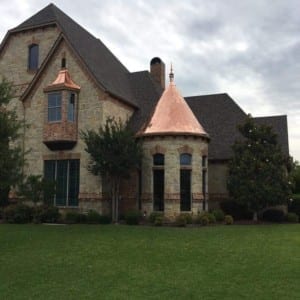Roof Styles
Gable Roof
Perhaps the most common roof shape, the Gable Roof (also called a “pitched roof”) is relatively easy to build, does a great job with water drainage, and offers good ventilation and a clean, attractive look. Often dormers, or mini window and roof extensions, are incorporated into this roofing style (as shown, right). This style of roof lends itself to nearly any type of roofing material.

Saltbox Roof
An asymmetrical Gable roof with one side longer than the other is referred to as a Saltbox roof. Homes with this roof style are traditionally found in New England, but more contemporary variations (like the example, right) can be found throughout the United States. Depending on how traditional or contemporary a particular saltbox home is, asphalt shingle, slate, cedar shake or even copper could all be appropriate roofing materials.

Hip Roof
A Hip roof is similar to a Gable roof, but it has four sides instead of just two. Hip roofs tend to be more stable than Gable roofs, due to the inward slope of the four sides. For this reason, this type of roof is often used in high wind areas. Any type of roofing material may be used with a Hip roof, but if cost is a consideration remember that more material will be required compared to a Gable roof due to this style’s greater square footage. The example here shows a Hip roof covered in cedar shake.
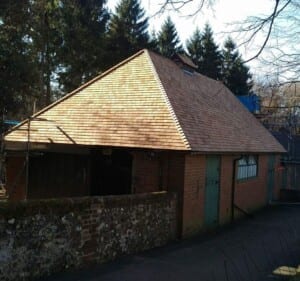
Bonnet Roof
A Bonnet roof is a variation on a Hip roof, in which the bottom portion of the hip roof pitches outward, like the brim of a hat. The extra overhang helps to keep the home cool. The example below shows a Bonnet roof home covered in asphalt shingles. Slate is another option to consider for a Bonnet roof home, although it will be more costly than asphalt.
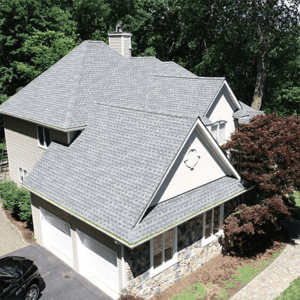
Mansard Roof
Mansard roofs are similar to a Hip roof, except the top portion is flat. This design originated in Western Europe. Homes with this roof style tend to be a bit more formal and often look very attractive with slate roof tiles. Asphalt shingles are available in a variety of colors, textures and thicknesses, making them a flexible option for this roof style as well.
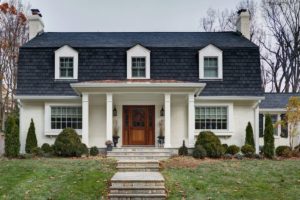
A-Frame Roof
As the name suggests, the sloping sides of this roof style form a point at the top to resemble the letter “A”. This type of roof is often found in areas that are prone to heavy snow, since the severely sloping shape can easily shake off snow and water. The rustic look of a home with this type of roof often lends itself to cedar shake.

Flat Roof
Frequently used in modern home and building design, a Flat roof may look completely level, but it is usually designed with some degree of grade that offers drainage for pooling water. Some variations on the Flat roof are the Butterfly roof (which looks like a V shape) and the Skillion roof (as shown, right) which has a more severe pitch for better drainage. Copper is a dramatic option for a Flat roof. Other common roofing materials for this style include zinc, thermoplastic or synthetic rubber.

Curved Roof
Queen Anne style homes and those with Victorian-inspired elements often incorporate a curved roof over a window or a round room on a tower. This type of roof tends to be more complex to build and to shingle. Common roofing materials for Curved roofs are cedar shakes and asphalt shingles, but copper is a beautiful option as well (as shown, right). Not every roofing contractor has experience with Curved roofs. It takes a high level of experience to be able to bend the roofing material to the roof’s curved shape.
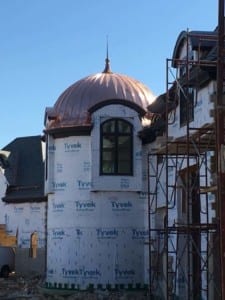
Arched Roof
Historic buildings, farm style homes and eco-green homes often featured Arched roofs, sometimes with skylights. The open, curved design of an Arched roof home results in a high distribution of natural light. Similar to Curved roofs, it is important to select a roofing contractor who has experience shingling a curved or arched surface. Common roofing materials for Arched roofs are cedar shakes, asphalt shingles and sometimes copper. These materials tend to be a bit more pliable and lend themselves to a curved application.
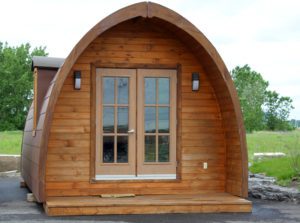
Combining Styles And Materials
Many newly designed homes incorporate different roofing styles and features, such as an arch over a window, a tower with a peak or domed roof or different height roofs connecting to form multiple valleys. An experienced roofing contractor can help ensure that the home has the correct roofing components so that water does not collect. An expert roofer can also advise on material selection, including the possibility of combining roofing materials as shown in this example.
Contact Alte Exteriors with any questions relating to roofing material selection. We are a family owned and operated, second generation New Jersey roofing company. Our expert roofers can help you evaluate different roofing materials based on the shape of your roof, location and architectural style of your home and your criteria for durability, cost and energy efficiency.
